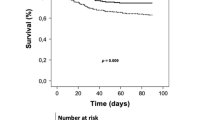Abstract
Background
A prospective trial was designed to evaluate the effect of hyperbaric oxygen (HBO) therapy on organ/space sternal surgical site infections (SSIs) following cardiac surgery that requires sternotomy.
Methods
A total of 32 patients who developed postoperative organ/space sternal SSI were enrolled in this study from 1999 through 2005. All patients were offered HBO therapy. Group 1 included the patients who accepted and were able to undergo HBO therapy (n = 14); group 2 included patients who refused HBO therapy or had contraindications to it (n = 18).
Results
The two groups were well matched at baseline with comparable preoperative clinical characteristics and operative factors. Staphylococcus was the most common pathogen for both groups. The duration of infection was similar in groups 1 and 2 (31.8 7.6 vs. 29.3 5.7 days, respectively, p = 0.357). The infection relapse rate was significantly lower in group 1 (0% vs. 33.3%, p = 0.024). Moreover, the duration of intravenous antibiotic use (47.8 ± 7.4 vs. 67.6 ± 25.1 days, p = 0.036) and total hospital stay (52.6 ± 9.1 vs. 73.6 ± 24.5 days, p = 0.026) were both significantly shorter in group 1.
Conclusion
Hyperbaric oxygen is a valuable addition to the armamentarium available to physicians for treating postoperative organ/space sternal SSI.
Similar content being viewed by others
References
The Parisian Mediastinitis Study Group (1996) Risk factors for deep sternal wound infection after sternotomy: a prospective, multicenter study. J Thorac Cardiovasc Surg 111:1200–1207
Petzold T, Feindt PR, Carl UM, et al. (1999) Hyperbaric oxygen therapy in deep sternal wound infection after heart transplantation. Chest 115:1455–1458
Tibbles PM, Edelsberg JS (1996) Hyperbaric-oxygen therapy. N Engl J Med 334(25):1642–1648
Horowitz MD, Portogues CG, Matos LA, et al. (1992) Hyperbaric oxygen: value in management of nonhealing saphenectomy wounds. Ann Thorac Surg 54:782–783
Schechter R (1998). Is oxygen an antibiotic? Lancet 352:1552–1553
Niinikoski J, Aho AJ (1983) Combination of hyperbaric oxygen, surgery and antibiotics in the treatment of clostridial gas gangrene. Infect Surg 2:23–37
Oriani G, Meazza D, Favales F, et al. (1990) Hyperbaric oxygen therapy in diabetic gangrene. J Hyperb Med 5:171–175
Clark LA, Moon RE (1999) Hyperbaric oxygen in the treatment of life-threatening soft-tissue infections. Respir Care Clin N Am 5:203–219
Korhonen K, Klossner J, Hirn M, et al. (1999) Management of clostridial gas gangrene and the role of hyperbaric oxygen. Ann Chir Gynaecol 88:139–142
Larsson A, Engstrom M, Uusijarvi J, et al. (2002) Hyperbaric oxygen treatment of postoperative neurosurgical infections. Neurosurgery 50:287–295
Mangram AJ, Horan TC, Pearson ML, et al. (1999) Guidelines for prevention of surgical site infection, 1999. Infect Control Hosp Epidemiol 20:250–258
Leach RM, Rees PJ, Wilmshurst P (1998) Hyperbaric oxygen therapy. BMJ 317:1140–1143
Kalani M, Jorneskog G, Naderi N, et al. (2002) Hyperbaric oxygen (HBO) therapy in treatment of diabetic foot ulcers: long-term follow-up. J Diabetes Complications 16:153–158
Niezgoda JA, Mewissen M (2004) The management of lower extremity wounds complicated by acute arterial insufficiency and ischemia. Ostomy Wound Manage 50(5A Suppl):1–11
Yildiz S, Uluutku H, Gunay A, et al. (2004) The effect of hyperbaric oxygen therapy on the adverse effects of octreotide on wound healing. Eur J Gastroenterol Hepatol 16:475–478
Cianci P (2004) Advances in the treatment of the diabetic foot: is there a role for adjunctive hyperbaric oxygen therapy? Wound Repair Regen 12:2–10
Faglia E, Favales F, Aldeghi A, et al. (1996) Adjunctive systemic hyperbaric oxygen therapy in treatment of severe prevalently ischemic diabetic foot ulcer: a randomized study. Diabetes Care 19:1338–1343
Zamboni WA, Browder LK, Martinez J (2003) Hyperbaric oxygen and wound healing. Clin Plast Surg 30:67–75
Hammarlund C, Sundberg T (1994) Hyperbaric oxygen reduced size of chronic leg ulcers: a randomized double-blind study. Plast Reconstr Surg 93:829–833
Sugihara A, Watanabe H, Oohashi M, et al. (2004) The effect of hyperbaric oxygen therapy on the bout of treatment for soft tissue infections. J Infect 48:330–333
Wilkinson D, Doolette D (2004) Hyperbaric oxygen treatment and survival from necrotizing soft tissue infection. Arch Surg 139:1339–1345
Mader JT, Guckian JC, Glass DL, et al. (1978) Therapy with hyperbaric oxygen for experimental osteomyelitis due to Staphylococcus aureus in rabbits. J Infect Dis 138:312–318
Sakoda M, Ueno S, Kihara K, et al. (2004) A potential role of hyperbaric oxygen exposure through intestinal nuclear factor-kappaB. Crit Care Med 32:1722–1729
Cohen AJ, Lockman J, Lorberboym M, et al. (1999) Assessment of sternal vascularity with single photon emission computed tomography after harvesting of the internal thoracic artery. J Thorac Cardiovasc Surg 118:496–502
Lambertsen CJ, Kough RH, Cooper DY, et al. (1953) Oxygen toxicity: effects in man of oxygen inhalation at 1 and 3.5 atmospheres upon blood gas transport, cerebral circulation and cerebral metabolism. J Appl Physiol 5:471-486
Niinikoski JH (2004) Clinical hyperbaric oxygen therapy, wound perfusion, and transcutaneous oximetry. World J Surg 28:307–311
Knighton DR, Halliday B, Hunt TK (1986) Oxygen as an antibiotic: a comparison of the effects of inspired oxygen concentration and antibiotic administration on in vivo bacterial clearance. Arch Surg 121:191–195
Park MK, Myers RA, Marzella L (1992) Oxygen tensions and infections: modulation of microbial growth, activity of antimicrobial agents, and immunologic responses. Clin Infect Dis 14:720–740
Acknowledgments
We thank Mrs. Sarah Palmisano, Mr. Filippo Barili, and Mr. Ariel A. Benson for their valuable help in preparing and revising this manuscript.
Author information
Authors and Affiliations
Corresponding author
Rights and permissions
About this article
Cite this article
Barili, F., Polvani, G., Topkara, V.K. et al. Role of Hyperbaric Oxygen Therapy in the Treatment of Postoperative Organ/Space Sternal Surgical Site Infections. World J Surg 31, 1702–1706 (2007). https://doi.org/10.1007/s00268-007-9109-0
Published:
Issue Date:
DOI: https://doi.org/10.1007/s00268-007-9109-0




